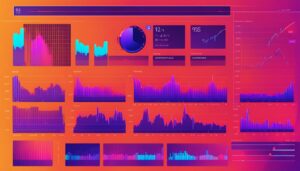In the world of forex trading, understanding spreads is essential for success. But what exactly is a spread in forex trading? And why does it matter?
A forex spread is the difference between the exchange rate that a forex broker sells a currency and the rate at which they buy the currency. It is essentially the cost of trading in the forex market. Currencies are quoted in pairs, such as USD/EUR or GBP/JPY, with the first currency being the base currency and the second currency being the quote currency.
The spread is measured in pips, which is the smallest unit of movement in the price of a currency pair. For example, if the EUR/USD currency pair has a spread of 2 pips, it means the broker is selling the euro at a slightly higher price and buying it at a slightly lower price compared to the market rate.
Key Takeaways:
- The forex spread is the difference between the buying and selling price of a currency pair.
- Spreads are measured in pips, which is the smallest unit of movement in the price of a currency pair.
- Currencies are quoted in pairs, with the first currency as the base currency and the second currency as the quote currency.
- Understanding spreads is crucial for calculating transaction costs and optimizing trading strategies.
- There are different types of spreads in forex trading, including fixed spreads and variable spreads.
How Does Spread Work in Forex?
In forex trading, understanding how spread works is essential. The bid price, which is the price at which the broker is willing to buy the base currency, and the ask price, which is the price at which they are willing to sell the base currency, determine the spread. Forex quotes always include bid and ask prices, similar to equity markets. The spread can vary depending on various factors, including the currency pair, time of day, and economic conditions.
Brokers have the ability to add to or widen their bid-ask spread. This means that investors would pay more when buying and receive less when selling. Average spreads in forex trading usually range from one to five pips. However, during periods of high volatility, spreads can be wider. It’s crucial for investors to monitor the spread and consider it when calculating transaction costs.
To illustrate, let’s consider an example:
EUR/USD is currently trading with a bid price of 1.2000 and an ask price of 1.2003. The difference between the bid and ask price is the spread, which in this case is 3 pips.
Monitoring the spread is vital as it directly impacts the cost of entering and exiting positions in forex trading. By being aware of the spread, investors can make more informed decisions and optimize their trading strategies.
Bid-Ask Spread in Forex
The bid-ask spread in forex represents the difference between the highest price a buyer is willing to pay (bid) and the lowest price a seller is willing to accept (ask). This spread is determined by market demand and supply conditions, as well as the liquidity of the currency pair being traded. Higher market liquidity usually results in tighter bid-ask spreads, while lower liquidity can lead to wider spreads.
Average Spreads in Forex
The average spreads in forex trading can vary among currency pairs and brokers. Major currency pairs, such as EUR/USD, typically have tighter spreads due to their high liquidity. On the other hand, less frequently traded currency pairs often have wider spreads. It’s important for traders to compare spreads offered by different brokers and choose the one that offers competitive pricing and favorable trading conditions.
Spreads Explained in Forex Trading
Spreads are an integral part of forex trading and understanding how they work is crucial for successful trading. By considering the bid-ask spread, monitoring average spreads, and selecting brokers with competitive pricing, traders can effectively manage transaction costs and optimize their trading strategies.
Types of Spreads in Forex Trading
When it comes to forex trading, understanding the different types of spreads is vital. Spreads refer to the difference between the bid and ask prices of a currency pair, and they play a significant role in determining transaction costs. In this section, we will explore the two main types of spreads in forex trading: fixed spreads and variable spreads.
1. Fixed Spreads
Fixed spreads, as the name suggests, remain constant regardless of market conditions. This means that the spread offered by a broker does not change, providing traders with predictability in terms of transaction costs. Fixed spreads are ideal for traders who value stability and want to know the exact cost of each trade they execute. Market maker brokers typically offer fixed spreads.
2. Variable Spreads
Variable spreads, on the other hand, fluctuate based on the bid and ask prices in the market. They tend to be tighter during periods of low volatility and wider during times of high volatility. Variable spreads give traders the opportunity to potentially benefit from lower transaction costs when market conditions are favorable. Non-dealing desk brokers commonly offer variable spreads.
Traders often prefer tight spreads as they result in lower transaction costs and allow for potentially higher profits. It’s important to note that the type of spread offered by a broker depends on their business model. Understanding the different types of spreads and their implications can help traders make informed decisions when executing trades.
Overall, choosing the right type of spread is crucial for optimizing trading strategies and maximizing profitability. Whether it’s fixed spreads or variable spreads, both have their own advantages depending on market conditions and individual preferences. Traders should carefully consider their trading style, risk tolerance, and market conditions when selecting a broker and the type of spreads they offer.
Importance of Spreads in Forex Trading
Spreads play a crucial role in forex trading, influencing the overall cost of trading. Understanding spreads and their implications is essential for successful forex trading. Let’s delve deeper into why spreads are important in the world of forex.
First and foremost, tight spreads can result in lower transaction costs for traders. This means that traders can enter and exit positions with reduced expenses, allowing them to maximize their profits. Lower transaction costs can significantly impact the overall profitability of trading activities.
Additionally, tight spreads often indicate higher market liquidity. Liquidity refers to the ease with which a particular currency pair can be bought or sold without significantly affecting its price. When spreads are tight, it suggests a higher level of liquidity in the market. This higher liquidity can be advantageous for traders as it enables them to enter and exit positions more easily, minimizing the risk of slippage.
On the other hand, wider spreads can increase transaction costs and make it more challenging to execute trades at desired prices. It’s important for traders to keep an eye on spreads, especially during times of high volatility or economic events that can cause spreads to widen. Wider spreads can eat into potential profits and may require traders to adjust their trading strategies accordingly.
To illustrate the importance of spreads, let’s consider an example:
| Currency Pair | Average Spread (pips) |
|---|---|
| EUR/USD | 1.5 |
| GBP/USD | 2.0 |
| USD/JPY | 0.8 |
This table showcases the average spreads (in pips) for three popular currency pairs: EUR/USD, GBP/USD, and USD/JPY. As you can see, the spreads vary for each pair. Traders need to consider these spreads when calculating transaction costs and developing their trading strategies.
By understanding the importance of spreads in forex trading and closely monitoring them, traders can make informed decisions, adapt their strategies, and potentially enhance their profitability.
Factors Influencing Forex Spreads
Understanding the factors that influence forex spreads is essential for successful trading. Several key elements can impact the spread in the forex market:
Market Volatility
Market volatility is a significant driver of spread widening. When there is high volatility, there is often less liquidity in the market, leading to larger spreads. Traders should be aware that during periods of increased volatility, such as economic data releases or geopolitical events, spreads may widen.
Economic and Geopolitical Events
Economic and geopolitical events can also have a significant impact on spreads. Sudden changes in market sentiment due to these events can lead to wider spreads. Traders should pay close attention to news and economic indicators to anticipate potential spread changes.
Time of Day
The time of day can also influence forex spreads. Different trading sessions have varying levels of liquidity, which can affect the spread. For example, during periods of low liquidity, such as holidays or late-night trading sessions, spreads can be wider. Traders should be mindful of these time periods when considering their trading strategies.
By considering these factors, traders can better understand and monitor spreads, allowing them to make more informed trading decisions. Monitoring spreads, along with other market factors, is crucial for optimizing trading strategies and managing transaction costs.
How to Monitor Forex Spreads
Monitoring forex spreads is essential for traders to make informed decisions and assess the overall cost of their trading activity. By staying updated on bid and ask prices in real-time, traders can effectively track spreads and anticipate changes. In addition, keeping an eye on economic indicators and news events that impact currency pairs can offer valuable insights into potential spread fluctuations.
One way to monitor forex spreads is by utilizing trading platforms that provide real-time bid and ask prices. These platforms often include spread indicators, which visually represent the current spread on a graph. Traders can easily observe the spread’s movement and analyze its patterns to improve their trading strategies.
Staying informed about economic indicators and news events is equally important in monitoring spreads. By staying up-to-date with market trends and events, traders can anticipate potential spread changes and adjust their trading plans accordingly. This proactive approach helps traders make informed decisions and potentially mitigate risks.
Overall, monitoring spreads is crucial for traders to optimize their trading performance and minimize transaction costs. By utilizing advanced tools and staying informed, traders can stay one step ahead in the forex market and improve their profitability.

Key Strategies for Monitoring Forex Spreads:
- Use trading platforms that provide real-time bid and ask prices.
- Take advantage of spread indicators to visually track spread movements.
- Stay informed about economic indicators and news events that impact currency pairs.
- Analyze spread patterns and trends to improve trading strategies.
Conclusion
Understanding Forex spreads is crucial for currency traders looking to navigate the intricate world of foreign exchange. A Forex spread refers to the difference between the buying and selling prices of a currency pair and serves as a measure of transaction costs. By comprehending the concept of spreads and how they operate, traders can make informed decisions regarding their positions.
Forex spreads are not static and can vary based on numerous factors, such as market conditions, liquidity, and the broker selected. It is important for traders to monitor spreads closely to gauge the overall expenses associated with their trades. Keeping a watchful eye on spreads, along with considering other market factors, can help optimize trading strategies and potentially enhance profitability.
As traders delve deeper into the realm of Forex, they must gain a solid understanding of spreads to navigate the ever-changing landscape of the foreign exchange market. By staying knowledgeable about spreads and the factors affecting them, traders can make calculated decisions that align with their objectives. Armed with this knowledge, traders can seek opportunities, mitigate risks, and ultimately strive for success in their Forex trading endeavors.
FAQ
What is a spread in Forex trading?
The spread in Forex trading refers to the difference between the exchange rate that a Forex broker sells a currency and the rate at which they buy the currency.
How does spread work in Forex?
The bid price is the price at which the broker is willing to buy the base currency, and the ask price is the price at which they are willing to sell the base currency. The difference between the bid and ask price is the spread.
What are the types of spreads in Forex trading?
There are two main types of spreads in Forex trading: fixed spreads and variable spreads.
Why are spreads important in Forex trading?
Spreads play a crucial role in Forex trading as they impact the overall cost of trading and can influence profitability.
What factors can influence Forex spreads?
Several factors can influence Forex spreads, including market volatility, economic conditions, and liquidity of a currency pair.
How can I monitor Forex spreads?
Traders can monitor Forex spreads by using trading platforms that provide real-time bid and ask prices and offer spread indicators.
What is the Forex spread definition?
The Forex spread refers to the difference between the buying and selling prices of a currency pair.





